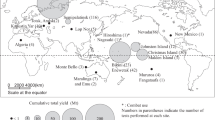Abstract
Atmospheric tritium concentrations of tritiated water vapor (HTO), tritiated hydrogen (HT) and tritiated hydrocarbons (primarily tritiated methane, CH3T) have been measured in Fukuoka prefecture, Japan from 1984 to the present to establish a general database on the behavior of atmospheric tritium. HTO concentrations expressed in Bq/l-H2O vary within a range of 1.19 to 2.45, giving an overall average value of 1.86±0.077. HTO concentrations expressed in-mBq/m3-air vary within a range of 7.8 to 46.1 and have a strong correlation with the atmospheric humidity, being high in the summer and low in winter. In the case of HT and CH3T, no seasonal variations were observed with average monthly values of 23.1 to 61.0 mBq/m3-air and 8.3 to 23.9 mBq/m3-air, respectively. The present HTO concentrations are already close to the tritium level before nuclear testings. However, the present HT and CH3T concentrations are still higher by a factor of about 140 and 30, respectively, than those before the testings. Specific activities are estimated to be 14.6–16.7 TU for HTO, 5.5·105–1.0·106 TU for HT and 3.2·104–4·104 TU for CH3T. The apparent difference in the specific activities suggests a very slow transformation of these species in the atmosphere or a continuous supply of HT and CH3T with high specific activity. Residence time for atmospheric HT was found to be 6.5 years over the period 1988–92 and 10 years for 1988–95. These times are longer than 4.8 years given by Mason and Östlund in the 1970s, and thus indicate a supply to the atmosphere of HT from various tritium sources.
Similar content being viewed by others
References
W. R. Schell et al., IAEA/STI/PUB/354, 1974, p. 375.
L. L. Burger, IAEA/STI/PUB/498, 1979, p. 47.
T. Okai, Y. Takashima, J. Radioanal. Nucl. Chem., 130 (1989) 399.
P. Fabian et al., J. Geophys. Res., 84 (1979) 3149.
E. A. Scranton, W. H. Langham, Health Phys., 38 (1980) 1087.
D. R. Blake, Geophys. Res. Lett., 9 (1982) 477.
M. A. K. Khalil, R. A. Rusmussen, Tellus, 42B (1990) 229.
N. Momoshima et al, J. Radioanal. Nucl. Chem., 104 (1986) 141.
N. Matsuoka et al., Proc. of the 7th IUAPPA Regional Conference on Air Pollution and Waste Issues, Volume IV, November 2–4, Taipei, 1994, p. 111.
A. S. Mason, H. G. Östlund, Tritium Laboratory Data Report No. 7, Rosenstiel School of Marine and Atmospheric Science, University of Miami, 1977.
K. Kigoshi, K. J. Yoneda, Geophys. Res., 75 (1970) 2981.
H. Buttlar, W. F. Libby, J. Inorg. Nucl. Chem., 1 (1955) 75.
A. S. Mason, H. G. Östlund, IAEA/STI/PUB/498, 1979, p. 3.
H. Djerassi, W. Gulden, Fusion Technol., 14 (1988) 1216.
C. D. Burnham et al, Fusion Technol., 14 (1988) 1159.
H. Noguchi, T. Matui, M. Murata, Fusion Technol., 14 (1988) 1187.
P. A. Davis et al., Fusion Technol., 28 (1995) 833.
Y. Ichimasa et al., Fusion Technol., 28 (1995) 877.
H. Forstel, Radiat. Prot. Dosim., 16 (1986) 75.
V. Faltings, P. Z. Harteck, Z. Naturforsch., 5a (1950) 438.
E. L. Fireman, F. S. Roeland, J. Geophys. Res., 66 (1961) 4321.
F. J. Begemann, J. Geophys. Res., 68 (1963) 3757.
Intergovernmental Panel on Climate Change 1996, The Press Syndicate of the University of Cambridge, 1996, p. 69.
Author information
Authors and Affiliations
Rights and permissions
About this article
Cite this article
Okai, T., Momoshima, N. & Takashima, Y. Variation of atmospheric tritium concentrations in three different chemical forms in Fukuoka, Japan. J Radioanal Nucl Chem 239, 527–531 (1999). https://doi.org/10.1007/BF02349063
Received:
Issue Date:
DOI: https://doi.org/10.1007/BF02349063




